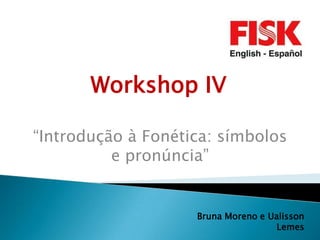
Fonética: símbolos e pronúncia
- 1. Workshop IV “Introdução à Fonética: símbolos e pronúncia” Bruna Moreno e Ualisson Lemes
- 2. “Dentro das instituições que dizem adotar a abordagem comunicativa,parece não haver consenso a respeito da importância do ensino dessa habilidade [pronúncia] para a aprendizagem. Enquanto um número de professores de Inglês como LE acreditam que o ensino da pronúncia seja uma prática ultrapassada e conservadora, dando mais importância ao ato de comunicar em si,outros já concebem o ensino da pronuncia como um aspecto essencial para garantir o sucesso da capacitação do aluno.”
- 3. Hoje se compreende que o ensino de pronúncia deve seguir um caminho mais balanceado. Tendo clara a importância tanto de reconhecer sons com alta carga funcional, ou seja, distintivos (como a vogal em least and list), quanto de reconhecer aspectos suprasegmentais, como entonação e tonicidade.
- 4. Phone: One of many possible sounds in the languages of the world. The smallest identifiable unit found in a stream of speech. E.g.: [p] Phoneme: A contrastive unit in the sound system of a particular language. A minimal segmental unit that serves to distinguish between meanings of words. E.g.: /p/
- 5. Allophones: An allophone is a phonetic variant of a phoneme in a particular language. There are different phones representing the same phoneme. E.g.: [ph] inicial position, as in pat /p/ [p] following a initial /s/, not aspirated, as in spin [p ] final position, lips remain closed and the the /p/ unreleased, as in cup
- 7. Sound Examples Sound Examples 1. /b/ boy, cab 13. /ʒ/ leisure, beige 2. /p/ pie, lip 14. /ʃ/ shy, dish 3. /d/ dog, bed 15. /h/ his, ahead 4. /t/ toe, cat 16. /tʃ/ cheek, watch 5. /g/ go, beg 17. /dʒ/ joy, budge 6. /k/ cat, back 18. /m/ me, seem 7. /v/ view, love 19. /n/ no, sun 8. /f/ fill, life 20. /ŋ/ sing, singer 9. /ð/ the, bathe 21. /l/ long, full 10. /θ/ thin, bath 22. /r/ run, car 11. /z/ zoo, goes 23. /w/ win, away 12. /s/ see, bus 24. /j/ you, soya
- 8. How do you pronounce this word? ghoti
- 9. /fɪʃ/ Explanation: gh = /f/ as in tough and rough o = /ɪ/ as in womem ti = /ʃ/ as in nation Invented by George Bernard Shaw
- 10. Shoe Ocean Sugar Nauseous Issue Conscious Mansion Chaperon Mission Schist Nation Fuschia Suspicion Pshaw
- 11. Consonant phonemes can be distinguished along three main dimensions: 1. Voicing: whether or not the vocal cords are vibrating /s/ voiceless /z/ voiced
- 12. 2. Place of Articulation: Air passes through the oral cavity (mouth) or the nasal passageway (nose), or through both. articulator: movable part of the articulatory system (mainly the lower lip and various parts of the tongue) place of articulation: Where the contact with the articulators occurs
- 14. The places of articulation summarized: Bilabial: produced with the two lips. Labiodental: produced with the upper teeth and inner lower lip Dental: produced with the tongue tip on or near the inner surface of the upper teeth
- 15. Alveolar: produced with the tongue tip on or near the tooth ridge Palatal: produced with the tongue blade or body near the hard palate Velar: produced with the tongue body on or near the soft palate Glottal: Produced by air passing from the windpipe through the vocal cords
- 16. 3. Manner of articulation: Level of obstruction in the air flow as it encounters the obstacles of the speech organs. Stop: the airstream is stopped completely prior to release Fricative: air is forced through a narrow passageway criating friction Affricate: the sound begins as a stop and is then released as a fricative Nasal: continuous air is released through the nasal cavity while the speech organs assume a stop like position Approximant: the airstream moves around the tongue in a relatively unobstructed way. They are of two kinds: the liquids and the glides(semivowels).
- 17. Vowel: the peak of the syllable, which mightbe composed of a single vowel. all voiced. relatively unobstructed air flow changes in shape and size of the oral cavity three types: 1. Simple vowels 2. Glides 3. Diphtongs
- 19. Parts of the tongue involved: Front, central, back Positions of the tongue: High, mid, low Position of the lips: Rounded, spread, neutral
